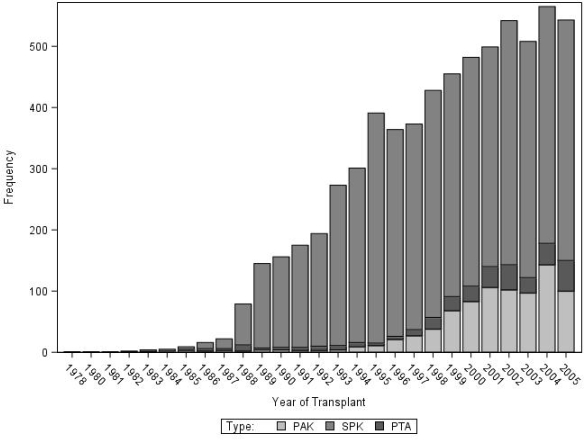Pancreas Graft Function >10 Years: The Cumulative US Experience
1SUNY Downstate Medical Center, Broooklyn, NY
2SUNY Upstate Medical University, Syracuse, NY.
Meeting: 2018 American Transplant Congress
Abstract number: 377
Keywords: Graft function, Pancreas transplantation
Session Information
Session Name: Concurrent Session: Pancreas and Islet - 1
Session Type: Concurrent Session
Date: Monday, June 4, 2018
Session Time: 4:30pm-6:00pm
 Presentation Time: 5:42pm-5:54pm
Presentation Time: 5:42pm-5:54pm
Location: Room 4C-3
Background and Study Purpose: The cumulative US experience with long-term pancreas graft function has not been reported.
Methods: Between 1966 and 2005, 18,197 pancreas transplants due to diabetes mellitus were reported to UNOS/IPTR with follow-up times >10 years. Uni- and multivariate statistical methods were used to describe characteristics, outcomes and risk factors.
Results: At the time of analysis, 6,728 recipients with >10 year pancreas graft function were identified. The majority were SPK in 82%, followed by PAK in 13% and PTA in 5%. Most were primary transplants (96%), but also second (221), third (14) and one fourth transplant worked long-term. Of note, the registry follows right now 644 pancreas transplant recipients with pancreas graft function over 20 years.
Figure 1 shows the increasing number of transplants with long-term graft function (>10 years) over time. After the 10-year mark was reached, median patient survival for these recipients was 10.7 years; the additional median graft function was 9.7 years. The age of recipients with long-term graft function increased over time to a median of 41 years at the time of transplant; the donor age decreased to a median of 22 years over time. The median preservation time was 12 hours. 
Of the recipients with >10 year graft function, 56% died with a functioning graft and 26% lost their graft for immunological reasons over the following 5 years. The most common causes of death with functioning graft were cardiovascular complications (25%), infections (12%) and malignancies (11%).
Conclusions: >10 year pancreas graft function can be achieved specifically in older recipients and young donors with short preservation times. Improvements in immunosuppression over time have also increased the number of grafts with long-term function. The effect of improved immunosuppressive protocols will be even more expressed in future years.
CITATION INFORMATION: Gruessner A., Laftavi M., Pankewycz O., Gruessner R. Pancreas Graft Function >10 Years: The Cumulative US Experience Am J Transplant. 2017;17 (suppl 3).
To cite this abstract in AMA style:
Gruessner A, Laftavi M, Pankewycz O, Gruessner R. Pancreas Graft Function >10 Years: The Cumulative US Experience [abstract]. https://atcmeetingabstracts.com/abstract/pancreas-graft-function-10-years-the-cumulative-us-experience/. Accessed December 29, 2025.« Back to 2018 American Transplant Congress
